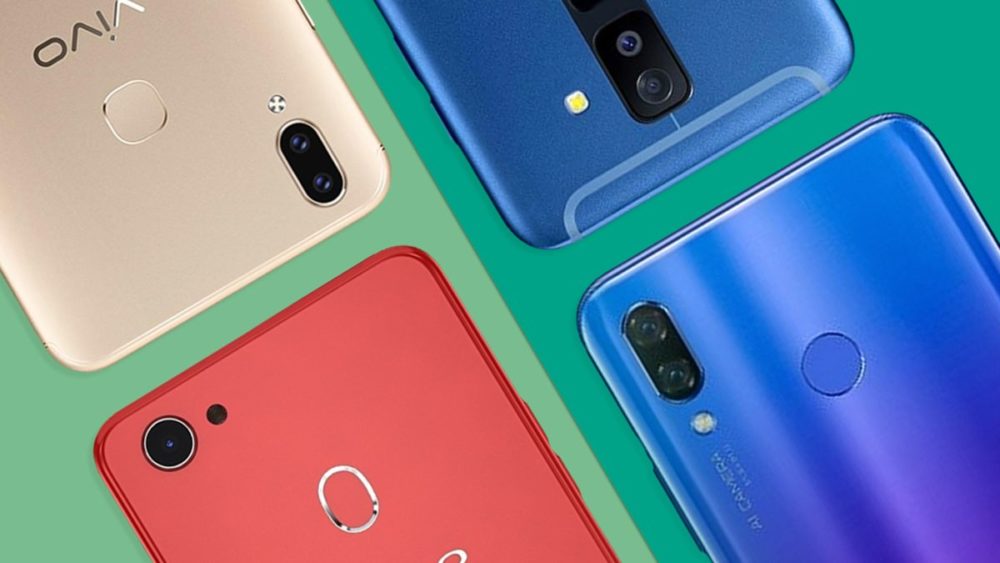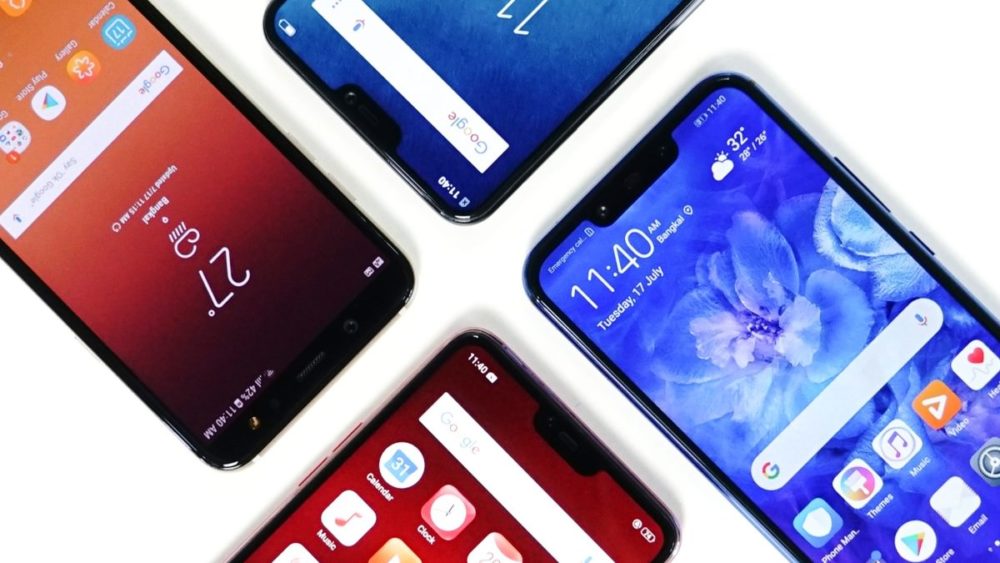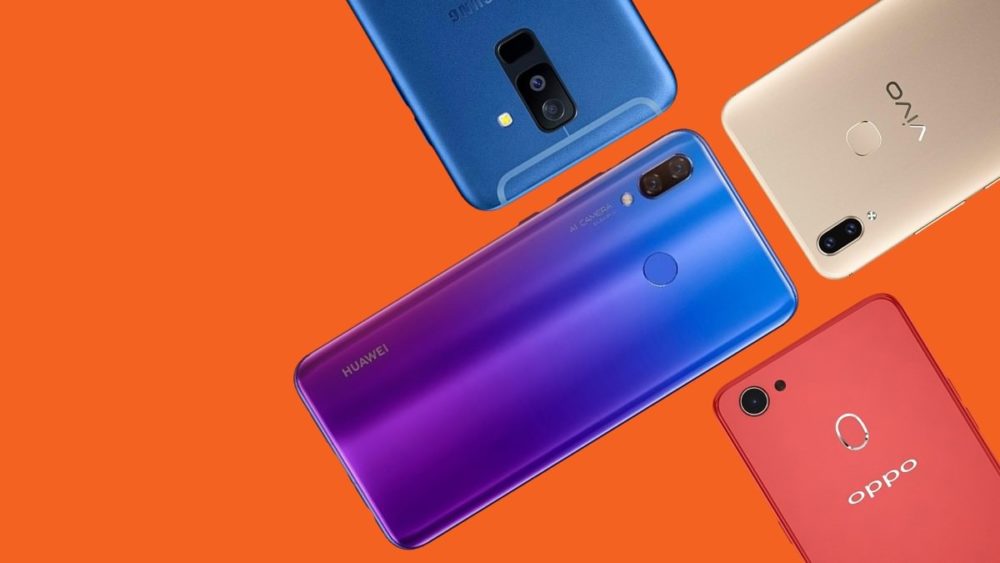Table of Contents
The mid-range smartphone competition is getting very tight with so many players vying for the top spot in the 15k to 20k price segment.
Among the more aggressive players are OPPO and VIVO with Samsung repositioning its line-up with the Galaxy A6 from the J-series and Huawei trying to get a repeat performance with their Nova line.

This year, it’s looking to be a 4-way battle between the newly launched Huawei Nova 3i, Samsung Galaxy A6, VIVO V9 and the OPPO F7.
So we look at each one of them both on paper and in real-life to see which device has the edge over everybody else in various categories.
Here are the categories we considered in this round-up:
We’ve already had enough hands-on time with all 4 contenders so we pretty much have a good idea of each one’s best features.

Design and build can be a bit subjective with any device. In our attempt to distinguish one over the other, we also look at the materials used, the uniqueness of the design and the attention to detail.
The Galaxy A6 and Nova 3i use metal frame while the V9 and F7 use polycarbonate materials which is a commonly used for smartphones. It is light, with thermal and impact resistant light but can easily be scratched as well.
We liked the design and finish of the OPPO F7 and the Nova 3i especially the details at the back. While the F7 has polished polycarbonate back panel, the Nova 3i uses a glass back, giving it a premium feel.
We’re giving this round to the Huawei Nova 3i for the metal frame and glass back panel followed closely by the OPPO F7, the VIVO V9, and the Galaxy A6.
The OPPO F7 uses a 6.23-inch FHD+ (2280 x 1080) LTPS IPS display which equates to a good 405ppi pixel density. It has a 19:9 aspect ratio and an 82.5% screen-to-body ratio. It also uses Gorilla Glass 5 up front for maximum screen protection.
At 6.3-inches, the Vivo V9 is among the biggest in this category. It comes in a 19:9 aspect ratio like the F7 with a Full HD+ or 1080×2280 pixel resolution and a high 85.2% screen-to-body ratio. There’s 2.5D Corning Gorilla Glass 3 for screen protection as well.

Equally sizable is the Huawei Nova 3i with its 6.3-inch IPS FullView display in a full HD+ resolution of 2340×1080 pixels and a slightly taller 19.5:9 aspect ratio. We’re quite surprised though it only has an 81% screen-to-body ratio.
Finally, the Galaxy A6 comes with a smaller 5.6-inch Super AMOLED display with an HD+ resolution or 720×1480 pixels and lower 75% screen-to-body ratio.
We give this round to the VIVO V9 and the OPPO F7 for the Gorilla Glass protection.
The Nova 3i came in very close at 3rd (we would have called it a 3-way tie if it had Gorilla Glass protection) and the Galaxy A6 is last.

Comparing cameras is complicated because of so many factors. For one, some have a single rear and front camera, while others like the Nova 3i that goes up to four -– 2 up front and 2 at the back.
The OPPO F7 is equipped with a 16MP rear camera and 25MP front camera with AI features and Screen Flash. It has scene recognition which supports 16 scenes and objects, HDR, Depth Effect, Panorama, Expert mode (Manual), AR Sticker with 14 effects, Vivid Mode which simply enhances the color, and Beauty with 6 levels of adjustments. There’s an AI-assisted Beauty mode but is only available for the front camera.
The Vivo V9 uses a dual-rear camera setup consisting of a 16MP primary and a 5MP secondary to aid in bokeh effects which can simulate apertures from f/16 to f/0.95. Features include Professional mode, Panorama, Face Beauty, AR stickers, HDR, Live Photo, Ultra HD, PPT mode, Slow motion, and Time-Lapse.
One of the main features of the Nova 3i is its cameras. It still has four cameras like the Nova 2i but it’s now more powerful and comes with extra features. It has a 16MP + 2MP rear cameras, and 24MP f/2.0 + 2MP front cameras. Like with the Nova 2i, the 2MP secondary sensors are there to aid in bokeh effects.
It’s got plenty of features like Pro, Slow-mo, Night, Panorama, Light painting, HDR, Time-lapse, 3D Panorama, Document scan, Beauty, Aperture, Portrait, and AR Lens which we will discuss in a bit. It also has an AI scene recognition which can detect up to 22 different scenes.
The AR Lens feature is one of the most fun to use. Aside from “stickers” that are found in other mid-range smartphones, it has the 3D Qmoji which is similar to the iPhone X’s Animoji, Backgrounds which adds animations to your background, and since the device supports Google ARCore, it has the 3D Objects feature which adds animated objects in Augmented Reality.
The Nova 3i is our pick when using the rear camera and the VIVO V9 and OPPO F7 wins the front-facing camera. This was determined by doing a blind comparison test among editors in the team.
We’re giving this round to the Nova 3i followed by the VIVO V9 and OPPO F7 tied in second place and Galaxy A6 placing last.

Computing power is at the heart of any smartphone. It dictates the performance of the device – how fast it runs and how smooth the operation, especially when we’re dealing with intensive apps and games.
To help us be more objective and add perspective in this category, we looked at synthetic benchmarks (in this test, we used Antutu v7) to determine their raw power.
Here are the results of the test:
| Huawei Nova 3i | OPPO F7 | Samsung Galaxy A6 (2018) | Vivo V9 | |
|---|---|---|---|---|
| CPU | HiSilicon Kirin 710 2.2GHz octa-core | MediaTek Helio P60 2.0GHz octa-core | Samsung Exynos 7870 1.6GHz octa-core | Qualcomm Snapdragon 626 2.2GHz octa-core |
| GPU | Mali-G51 | Mali-G72 MP3 | Mali-T830 MP2 | Adreno 506 |
| AnTuTu v7 | 138,548 | 138,758 | 63,218 | 88,226 |
The Kirin 710 is composed of a quad-core ARM Cortex A73 running at 2.2GHz coupled with a quad-core Cortex A53 at 1.7GHz. This is the same setup as the OPPO F7’s Helio P60 – a quad-core ARM Cortex A73 at 2.0GHz and quad-core Cortex A53 2.0GHz.
Where the two differs is in the GPU – the F7 uses a Mali G72 MP3 while the 3i only has a Mali G51 MP6.
On the other hand, both the Exynos 7870 and the Snapdragon 626 is composed of 8-core ARM Cortex A53 with the SD626 running up to 2.2GHz while the 7870 goes up to 1.6GHz only.
Based in our Antutu benchmark, the F7’s P60 chipset and the Kirin 710 of the Nova 3i are statistically tied, followed by the Snapdragon 626 of the VIVO V9 and the Exysnos 7870 of the Galaxy A6.

System memory is essential in order to get a smooth and snappy performance especially when a lot of apps are loaded or are running in the background. For the most part, we can safely say that 4GB of RAM should be enough in a smartphone. Even a lot of the flagship devices have this amount of RAM with the exception of a few.
Nevertheless, more RAM is generally better. In this category, it’s a 3-way tie between the VIVO V9, Nova 3i and OPPO F7 (note: there’s a variant of the F7 that has 6GB of RAM but that’s a special edition with a higher price tag). Dead last is the Galaxy A6 with only 3GB of RAM.

Internal storage is a huge consideration considering the growing sizes of apps and games in the Google Play Store as well as the amount of media we download actually create (photos and videos).
The Nova 3i tops this category with 128GB of internal storage, followed by the VIVO V9 and OPPO F7 with 64GB (note: there’s a variant of the F7 that has 128GB of storage but that’s a special edition with a higher price tag) and trailed by the Galaxy A6 with a mere 32GB of internal storage.

Battery life is a little tricky. Bigger capacity (in mAh) does not always follow a longer battery life. This is because of other factors such as processor efficiency, display technology, and system optimization.
In order to determine this, we used a set of test to standardize the measurement. One if the PCMark Battery test and the second is the video loop test.
Here are the results of our test for all 4 devices.
| Specification | Huawei Nova 3i | OPPO F7 | Samsung Galaxy A6 (2018) | Vivo V9 |
|---|---|---|---|---|
| Battery Capacity | 3340mah battery | 3,400mAh battery | 3,000mAh battery | 3,260mAh battery |
| PC Mark Battery Test | 9 hours and 50 minutes | 11 hours and 20 minutes | 10 hours and 53 minutes | 11 hours and 38 minutes |
| Video Loop test | 13 hours and 30 minutes | 23 hours | 12 hours and 30 minutes | 11 hours and 44 |

The operating system is an essential component of a smartphone. Newer versions offer more features and better overall experience.
In this case, the VIVO V9, OPPO F7 and Huawei Nova 3i all run on the latest Android 8.1 Oreo while the Galaxy A6 is just a minor update behind at Android 8.0.
It’s a 3-way tie in this category with the A6 in dead last.
Filipino consumers are very price sensitive. The strategic pricing of a smartphone can make or break the success for the line.
Of the four smartphones, the Nova 3i is the most affordable at Php15,990USD 272INR 23,099EUR 260CNY 1,984, followed by the Galaxy A6 at Php16,490USD 281INR 23,821EUR 268CNY 2,046 and the OPPO F7 and VIVO V9 tied at Php17,990USD 307INR 25,988EUR 292CNY 2,233.
If you’re on a tight budget, the Nova 3i is the obvious choice here since it is priced the lowest among the four.

It’s a very tight race and here are the tally of the scores from each category:
| Category | Nova 3i | OPPO F7 | Samsung Galaxy A6 | VIVO V9 |
|---|---|---|---|---|
| Design & Build | ||||
| Display | ||||
| Processor | ||||
| RAM | ||||
| Storage | ||||
| Camera | ||||
| Battery | ||||
| OS | ||||
| Price | ||||
| TOTAL |
In this 4-way comparison, the Huawei Nova 3i stands out from the rest, winning a plurality of the categories we outline. It’s actually a very tight race between the Nova 3i and the OPPO F7 although the Php2,000USD 34INR 2,889EUR 32CNY 248 price difference between the two can be a huge consideration with buyers when you put them side by side.
Inching closely behind is the VIVO V9 and the Samsung Galaxy A6 in last place.
Further readings:

YugaTech.com is the largest and longest-running technology site in the Philippines. Originally established in October 2002, the site was transformed into a full-fledged technology platform in 2005.
How to transfer, withdraw money from PayPal to GCash
Prices of Starlink satellite in the Philippines
Install Google GBox to Huawei smartphones
Pag-IBIG MP2 online application
How to check PhilHealth contributions online
How to find your SIM card serial number
Globe, PLDT, Converge, Sky: Unli fiber internet plans compared
10 biggest games in the Google Play Store
LTO periodic medical exam for 10-year licenses
Netflix codes to unlock hidden TV shows, movies
Apple, Asus, Cherry Mobile, Huawei, LG, Nokia, Oppo, Samsung, Sony, Vivo, Xiaomi, Lenovo, Infinix Mobile, Pocophone, Honor, iPhone, OnePlus, Tecno, Realme, HTC, Gionee, Kata, IQ00, Redmi, Razer, CloudFone, Motorola, Panasonic, TCL, Wiko
Best Android smartphones between PHP 20,000 - 25,000
Smartphones under PHP 10,000 in the Philippines
Smartphones under PHP 12K Philippines
Best smartphones for kids under PHP 7,000
Smartphones under PHP 15,000 in the Philippines
Best Android smartphones between PHP 15,000 - 20,000
Smartphones under PHP 20,000 in the Philippines
Most affordable 5G phones in the Philippines under PHP 20K
5G smartphones in the Philippines under PHP 16K
Smartphone pricelist Philippines 2024
Smartphone pricelist Philippines 2023
Smartphone pricelist Philippines 2022
Smartphone pricelist Philippines 2021
Smartphone pricelist Philippines 2020
Riptonize says:
Why not put the Asus Zenfone 5 in the comparison
Kiro Ro says:
Please compare them with Asus Zenfone 5.
engrfrog says:
You just started a war.. lol. Nice comparison though.. I’ve been looking for something like this for days.. XD kudos to u sir!
Mac says:
Video Loop test for Oppo F7 is 23 hours, seriously? di ba yan typo? more like 13hours is believable.
Also, Oppo F7 is being sold at 15k now at Laz, Shopee, and some stores lately. This needs to be updated.
budoktulero says:
Waiting for Xiaomi Redmi Note 5 comparison :D
Vicoy says:
hi nagagawa din ba ng Nova 3i yung mga features ng F7 na habang nag games is pwede sumagot ng call without interrupting the games at pwede din mag message, pwede irecord ang movie na pinapanuod at pwede i screen shot?thanks sa sasagot?
june says:
please try to compare the new zenfone 5 lines. especially the 5Q which is closy priced around 15k. thanks
Penny Cuenca says:
Hi can you please compare huawei nova 3i with asus zenfone 5? I cant decide which one to buy. Many Thanks!